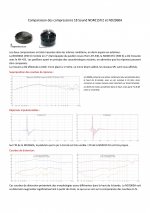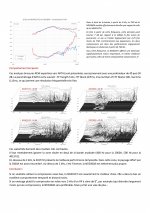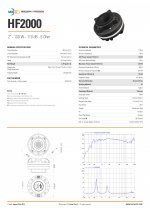N.B.
Hi Earl,
Some notes for others follow:
Regards Bill
1) Formula for the electromechanical coupling coefficient (ECC) should read explicitly ((BL)^2)/Re to avoid novitiate ambiguities.
2) If wire thickness in increased by a factor of 1.43, for an edge wound ribbon voice coil, then driver Re will be halved, but so will the (BL)^2 value as well; thus, ECC will remain constant for both cases.
3) L is the length of wire in the magnetic field, in and immediately surrounding, the voice coil gap.
4) For the case of the longer L, the resulting increased inductance (for all wire coils) may be mitigated by copper or silver plating pole piece gap surfaces,
Hi Earl,
Some notes for others follow:
Regards Bill
The misconception here is that the damping of a loudspeaker goes up as the resistance goes up. This is false.
>snip<
The damping (and efficiency) go as BL^2 / Re. Now if I lower Re with a given BL the damping will go up.
1) Formula for the electromechanical coupling coefficient (ECC) should read explicitly ((BL)^2)/Re to avoid novitiate ambiguities.
But if I simply change the wire in the voice coil then as the resistance goes down, the L will go down as well and generally the two changes cancel out. This means that the damping, which is reflected in the Qe, will stay about the same IF the magnetic circuit stays the same.
2) If wire thickness in increased by a factor of 1.43, for an edge wound ribbon voice coil, then driver Re will be halved, but so will the (BL)^2 value as well; thus, ECC will remain constant for both cases.
3) L is the length of wire in the magnetic field, in and immediately surrounding, the voice coil gap.
4) For the case of the longer L, the resulting increased inductance (for all wire coils) may be mitigated by copper or silver plating pole piece gap surfaces,
Last edited:

Here is the best I have to judge what my horn will perform like....I have the same horn but different exit size (1.5")
I noticed your first comment was regarding woofers separated by a horn, as in a MTM? or am I mistaken? I am most concerned with the TMM config.. Horn on top with the woofers below, vertically. Horizontally as an alternative.
That is a very beamy horn. Yes, I was talking MTM. MMT would be worse then either MTM or MT as it would have the problems of both without the benefits.
I see...and finally I think your last comment was directed towards the 2.5 but I am not sure...It sounds like you are saying there would be a power peak at crossover where only one of the woofers were active as it passes on to the horn....is that an issue? A 2.5 allows me to maintain the vertical (TMW ) configuration, while opening the polars back up relieving the issue of elevation of the woofer versus ear level. If I were to just separate the spectrum into 3 that would balance out the power, better...
Last edited:
JMLC's Horn Design Methodology
determines a horn boundary based on a wave front surface area expanding according to a specified mathamatical function (typically those developed by Vincinent Salmon in the 1930's). Even an OS horn, originally investigated by John Freehafer during the same time period, may be generated using this methodology; however, the resulting geometry at the mouth will be made different than that of OS horn to mitigate edge reflectance. The wave front geometry used closely approximates observed outbound wave fronts propagating in a typical acoustic horn. (Backwaves, HOMs and the like, constitute departures from this ideal.) To determine horn boundaries, facet dimensions over this surface are changed in an iterative process to converge on a desired surface area solution for each horn length increment required. The resulting horn boundries will be described by fairness curves possessing smooth 2nd. order derivatives. WHG
determines a horn boundary based on a wave front surface area expanding according to a specified mathamatical function (typically those developed by Vincinent Salmon in the 1930's). Even an OS horn, originally investigated by John Freehafer during the same time period, may be generated using this methodology; however, the resulting geometry at the mouth will be made different than that of OS horn to mitigate edge reflectance. The wave front geometry used closely approximates observed outbound wave fronts propagating in a typical acoustic horn. (Backwaves, HOMs and the like, constitute departures from this ideal.) To determine horn boundaries, facet dimensions over this surface are changed in an iterative process to converge on a desired surface area solution for each horn length increment required. The resulting horn boundries will be described by fairness curves possessing smooth 2nd. order derivatives. WHG
Last edited:
It's a beamy horn, yes, but camplo knew this beforehand.
The 630Hz XO point is in the ballpark for this particular JMLC horn. These are usually crossed between 600 and 650Hz.
The MTM may turn out to be the best configuration. Considering the horn's mouth circumference, it's nevertheless wise to keep other options open. This, once again, calls for modular bass cabs 😉
The 630Hz XO point is in the ballpark for this particular JMLC horn. These are usually crossed between 600 and 650Hz.
The MTM may turn out to be the best configuration. Considering the horn's mouth circumference, it's nevertheless wise to keep other options open. This, once again, calls for modular bass cabs 😉
Last edited:
I guess I didn't make myself clear 🙂 For that I apologize nor did I intend to insult you! "I've been on a quest to build my own own reference monitor." - I assumed that most peoples take on a reference monitor, in a studio setting, as a one mans show. Ether you are in the triangle or you aren't kinda thing. Especially with intentions of using tractrix/jmlc horn. My fault for assuming.
Been on various BBs/forums going on 23 yrs now and IME only a long gone forum dedicated to recording engineers used the description correctly on a regular basis and factor in all the speakers labeled [studio][reference] monitors that are or not or a dumbed down version of, so never crossed my mind.
Regardless, moving right along at my snail's pace, not sure I'm following all the other; I mean the woofers are canted/'focused' to create a crude 'C' with a radius = axial radius to your head center/whatever and if the ceiling gets in the way, angle its top to parallel it and mirror it on the bottom. Continue the curve with a separate, massive base and offset a rear panel brace at an acoustic or golden ratio like seen on some large BLHs.
Baffles should be at least horn width and preferably all rounded over after Geddes. With such a configuration the various reflections, bounces, et al that's left are randomized and that's what the various diffusor types, super heavy carpet/pad in recording studios are for and if there's any room boom, then build false wall absorbers as Dr. Geddes intimated.
Better to design the room right though, but don't recall any discussion on this most basic requirement so far or seen this or similar sites posted either: Acoustic Treatment and Design for Recording Studios and Listening Rooms
Re vented, I've fooled enough folks that claimed they can tell between sealed and an EBS alignment and in some cases just critically damped vented that for me it's a non issue and generally ignore any threads, papers on the subject. That said, tuning at even 30 Hz is borderline unless the room's longest wall is < ~525/30 = ~17.5 ft. since ideally need to critically damp it, which rolls off the deep bass somewhat, so need a bit of room help.
"The concern of the timbre caused by reverberation vs the lobing" What reverberation? Just how big is the room? Lobing in a 'focused' solo seat is irrelevant unless near walls and even then if angled enough it's randomized for easy damping. For extra 'free' damping, take your speaker-LP 'triangle' and offset it at odd angles to the room to really randomize/homogenize the acoustic landscape for quickest practical decay.
Anyway, this is a tried n' true configuration that's been being elaborated/tweaked to death by the high end boutique speaker system crowd for decades now, so all you got to do is wade through the myriad component choices the thread has generated to meet your performance goals.
GM
This one seems overlooked and why is it only one peak on the impedance measurement?
Eighteen Sound - Professional loudspeakers
Eighteen Sound - Professional loudspeakers
Duh, got a senile moment about the impedance, never seen it on a data sheet for cd's.
It's difficult to find any impartial info about this driver, anyone?
It's difficult to find any impartial info about this driver, anyone?
Waterfall/Distortion/impulse compared to ND4015Ti2 : Comparaison des compressions 18 Sound ND4015Ti2 et ND2060A.pdf
Re vented, I've fooled enough folks that claimed they can tell between sealed and an EBS alignment and in some cases just critically damped vented that for me it's a non issue and generally ignore any threads, papers on the subject. That said, tuning at even 30 Hz is borderline unless the room's longest wall is < ~525/30 = ~17.5 ft. since ideally need to critically damp it, which rolls off the deep bass somewhat, so need a bit of room help.
GM
Wisdom!
It's one of the aspects that distinguishes the best DIY efforts from commercially available large format systems.
Stereophile BS ratings have become the norm it seems, without much consideration of room effects.
80% of the available 15" (mid) woofers won't go much lower than 35Hz in BR cabs anyway, unless heavily boosted > JBL M2.
Rule of thumb: the best mid-bass is obtained with the lowest excursion possible.
Last edited:
Camplo, the 2.5 way is going to behave like a 2 way, when the .5 cuts in enough below the crossover. This method of baffle compensation is sometimes chosen because it is simple to implement and change.
Waterfall/Distortion/impulse compared to ND4015Ti2 : Comparaison des compressions 18 Sound ND4015Ti2 et ND2060A.pdf
Conclusion: The ND4015Ti2 is much better suited to low XO points and would therefore also be preferred for a big 2-way.
In fact, it would be a waste of the drivers' qualities to use it in a 3-way.
Compared to the FaitalPROs it's quite expensive though.
WRT low frequency performance, the Faital 2" drivers beat the ND2060 by a margin.
Attachments
Last edited:
.
The Faital 2" drivers beat the ND2060 by a margin.
'Which 2" Faital?
Waterfall/Distortion/impulse compared to ND4015Ti2 : Comparaison des compressions 18 Sound ND4015Ti2 et ND2060A.pdf
Thanks to you and Ro808!
'Which 2" Faital?
Mostly the big ones (3" Titanium diaphragm), but the smaller 2.56" Ketone Polymer diaphragms are not far behind.
Duh, got a senile moment about the impedance, never seen it on a data sheet for cd's.
Especially a 2" one allegedly 'tested' on a small 1" horn!!
GM
- Home
- Loudspeakers
- Multi-Way
- Is it possible to cover the whole spectrum, high SPL, low distortion with a 2-way?


